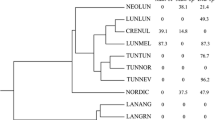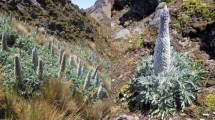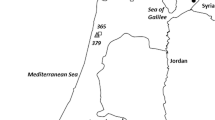Liatris helleri (Asteraceae) is an insect-pollinated herbaceous perennial endemic to several high-elevation sites in the Blue Ridge Mountains of North Carolina. Allozymes were used to describe the genetic diversity and population structure in nine populations of this rare, federally listed species. Differences in leaf morphology were also examined for greenhouse-grown plants representing several populations. The proportion of the total genetic diversity found among populations, as indicated by the allozyme data, was 16%. Higher levels of population differentiation were found for differences in leaf shape; population of origin accounted for 37% of the variation in maximum leaf width, while families within populations accounted for 7%. In contrast to many endemic species, L. helleri maintains fairly high levels of genetic diversity. For the species, the percent polymorphic loci was 87.5, the average number of alleles at variable loci was 3.00 and the gene diversity was 0.276. Mean population values were percent polymorphic loci =58.4, mean number of alleles per polymorphic locus =2.59 and gene diversity =0.219. The estimated gene flow was low (Nm=0.85–1.32) and a relatively high correlation (r=0.55; p<0.005) was found between linear geographic and genetic distance. This suggests that the populations are partially isolated by distance, despite the limited range (<60 km) of the species. We recommend that population distinetiveness be maintained in restoration efforts.
Similar content being viewed by others
References
Barrett, S.C.H. and Kohn, J.R. (1991) Genetic and evolutionary consequences of small population size in plants: implications for conservation. In Genetics and Conservation of Rare Plants (D.A. Falk and K.E. Holsinger, eds) pp. 3–30. New York: Oxford University Press.
Barton, N.H. and Slatkin, M. (1986) A quasi-equilibrium theory of the distribution of rare alleles in a subdivided population. Heredity 56, 409–15.
Cheliak, W.M. and Pitel, J.A. (1984) Techniques for Starch Gel Electrophoresis of Enzymes from Forest Tree Species. Petawawa National Forestry Institute, Information Report P1-X-42. Canadian Forestry Service, Agriculture, Canada.
Cole, C.T. and Biesboer, D.D. (1992) Monomorphism, reduced gene flow, and cleistogamy in rare and common species of Lespedeza (Fabaceae). Am. J. Bot. 79, 567–75.
Felsenstein, J. (1986) Population differences in quantitative characters and gene frequencies: A comment on papers by Lewontin and Rogers. Am. Nat. 127, 731–2.
Gaiser, L. (1946) The genus Liatris. Rhodora 48, 165–83, 216–63, 273–326, 331–82, 393–412.
Godt, M.J.W. and Hamrick, J.L. (1993) Genetic diversity and population structure in Tradescantia hirsuticaulis (Commelinaceae). Am. J. Bot. 80, 959–66.
Godt, M.J.W. and Hamrick, J.L. (in press) The mating system of Liatris helleri (Asteraceae), a threatened plant species, Heredity.
Gottlieb, L.D. (1977) Electrophoretic evidence and plant systematics. Ann. Miss. Bot. Garden 64, 161–80.
Hamrick, J.L. and Godt, M.J.W. (1989) Allozyme diversity in plant species. In Plant Population Genetics, Breeding and Genetic Resources (A.H.D. Brown, M.T. Clegg, A.L. Kahler and B.S. Weir, eds) pp. 43–63 Sunderland, MA: Sinauer.
Hedrick, P.W. (1985) Genetics of Populations. Boston: Jones and Bartlett.
Karron, J.D. (1987) A comparison of levels of genetic polymorphism and self-compatibility in geographically restricted and widespread plant congeners. Evol. Ecol. 1, 47–58.
Karron, J.D., Linhart, Y.B., Chaulk, C.A. and Robertson, C.A. (1988) Genetic structure of populations of geographically restricted and widespread species of Astragalus (Fabaceae). Am. J. Bot. 75, 1114–19.
Levin, D.A. and Kerster, H.W. (1969) Density-dependent gene dispersal in Liatris. Am. Nat. 103, 61–74.
Lewontin, R.C. (1984) Detecting population differences in quantitative characters as opposed to gene frequencies. Am. Nat. 123, 115–24.
Lewontin, R.C. (1986) A comment on the comments of Rogers and Felsenstein. Am. Nat. 127, 733–4.
Li, C.C. and Horvitz, D.G. (1953) Some methods of estimating the inbreeding coefficient. Am. J. Human Genet. 5, 107–17.
Mitton, J.B., Linhart, Y.B., Sturgeon, K.B. and Hamrick, J.L. (1979) Allozyme polymorphisms detected in mature needle tissue of ponderosa pine. J. Heredity 70, 86–9.
Moran, G.F. and Hopper, S.D. (1983) Genetic diversity and the insular population structure of the rare granite outcrop species, Eucalyptus caesia Benth. Austr. J. Bot. 31, 161–72.
Nei, M. (1972) Genetic distance between populations. Am. Nat. 106, 283–92.
Nei, M. (1973) Analysis of gene diversity in subdivided populations. Proc. Nat. Acad. Sci. USA 70, 3321–3.
Nei, M. (1977) F-statistics and analysis of gene diversity in subdivided populations. Ann. Human Genet. 41, 225–33.
Radford, A.E., Ahles, H.E. and Bell, C.R. (1968) Manual of the Vascular Flora of the Carolinas. Chapel Hill: University of North Carolina Press.
Rogers, A.R. (1986) Population differences in quantitative characters as opposed to gene frequencies. Am. Nat. 127, 729–30.
Rohlf, F.G. (1992) NTSYS-pc. Numerical taxonomy and multivariate analysis system. Setauket, NY: Exeter Software.
SAS (1988) SAS/Stat User's Guide, Release 6.03. Cary, NC: SAS Institute.
Schaal, B.A. (1974) Isolation by distance in Liatris cylindracea. Nature 252, 703.
Schaal, B.A. (1975) Population structure and local differentiation in Liatris cylindracea. Am. Nat. 109, 511–28.
Schaal, B.A. and Levin, D.A. (1978) Morphological differentiation and neighborhood size in Liatris cylindracea. Am. J. Bot. 65, 923–8.
Slatkin, M. (1985) Rare alleles as indicators of gene flow. Evolution 39, 53–65.
Soltis, D.E., Haufler, C.H., Darrow, D.C. and Gastony, D.J. (1983) Starch gel electrophoresis of ferns: a compilation of grinding buffers, gel and electrode buffers, and staining schedules. Am. Fern J. 73, 9–27.
Templeton, A.R. (1991) Off-site breeding of animals and implications for plant conservation strategies. In Genetics and Conservation of Rare Plants (D.A. Falk, K.E. Holsinger, eds) pp. 182–94. New York: Oxford University Press.
US Fish and Wildlife Service. (1989) Heller's Blazing Star Recovery Plan. Atlanta, GA: US Fish and Wildlife Service.
Workman, P.L. and Niswander, J.D. (1970) Population studies on southwestern Indian tribes. II. Local genetic differentiation in the Papago. Am. J. Human Genet. 22, 24–49.
Wright, S. (1922) Coefficients of inbreeding and relationship. Am. Nat. 56, 330–8.
Wright, S. (1931) Evolution in Mendelian populations. Genetics 16, 97–159.
Author information
Authors and Affiliations
Rights and permissions
About this article
Cite this article
Godt, M.J.W., Hamrick, J.L. Genetic diversity and morphological differentiation in Liatris helleri (Asteraceae), a threatened plant species. Biodivers Conserv 5, 461–471 (1996). https://doi.org/10.1007/BF00056391
Received:
Accepted:
Issue Date:
DOI: https://doi.org/10.1007/BF00056391




